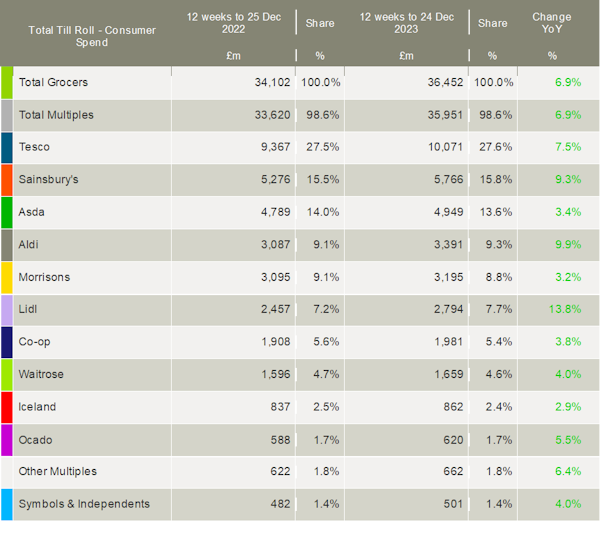Latest industry data from Kantar shows the leading supermarkets in the UK experienced their highest level of transactions in December since 2019 as they ramped up the level of promotions to attract shoppers. A record £13.7bn also passed through tills after a year of surging inflation, which led to the average household spending an all-time high of £477 across the month (+£28 compared to 2022).
Consumers made 488 million trips to the supermarkets over the four weeks to 24 December – 12 million more than last year and the largest number at Christmas since pre-pandemic times. Total take-home grocery sales grew in value by 7.0% while volumes rose by 2%.
Fraser McKevitt, head of retail and consumer insight at Kantar, commented: “As we expected, this Christmas was a whopper. Friday 22 December turned out to be the most popular shopping day when just over 25 million trips were made, and consumers spent £803m in physical stores – that’s 85% more than the average Friday in 2023.”
The Kantar data showed that grocery price inflation fell to 6.7% in December, its lowest level since April 2022. McKevitt said: “The rate of inflation is coming down at the fastest pace we have ever recorded, but consumers are still facing pretty hefty pressures on their budgets. Retailers were clearly working hard during the festive period to offer best value and win over shoppers, and promotions were central to their strategy. Nearly one-third of all spend in the four weeks to Christmas Eve was made on items with some kind of offer, the highest level since December 2020 and £823m more than last year.”
Tesco, Sainsbury’s, Asda, Morrisons and Waitrose accounted for a combined market share of 70% during the 12 weeks to 24 December. McKevitt commented: “The traditional retailers always tend to do well in the run-up to Christmas and this year was no exception.”
The shift to own-label lines continued during the period, with sales of premium ranges like Sainsbury’s Taste the Difference and Tesco Finest surging by 11.9% compared with last year to hit £790m – accounting for 5.7% of all grocery sales. Branded sales rose by 6.0% during the same period.
Sales at Sainsbury’s rose 9.3%, driving up its market share to 15.8% – its highest level since December 2020. Tesco gained 0.1 percentage points of share to hold 27.6% of the market after its sales grew by 7.5%.
Lidl and Aldi continued to be the fastest-growing grocers, hitting their highest-ever market shares for the Christmas period. Lidl increased sales by 13.8%, while Aldi saw growth of 9.9%. Lidl’s market share rose by 0.5 percentage points to 7.7% and Aldi’s grew 0.2 percentage points to 9.3%.
It was a disappointing period for Asda, with its sales growing just 3.4% and market share slipping to 13.6%. Spending at Morrisons increased by only 3.2%, with its share now standing at 8.8%.
Online purchases grew slightly ahead of the market during the four weeks to 24 December versus last year, up by 7.5%. Spending at Ocado grew by 5.5%, although its share of the market was unchanged at 1.7%.

NAM Implications:
- Good performance, but containing high inflation and new store sales…
- More worrying (for the mults) is the discounter gain of new customers at their expense.
- And having tried (and found acceptable quality), the issue becomes one of concern for brands.
- i.e. ultimate questioning of the size of the brand premium…
- Meanwhile, this progress is a challenge for Lidl’s bottom line…
- i.e. although Aldi & Lidl are each bigger than Tesco globally…
- …there has to be a limit to Lidl’s willingness to carry the UK passenger.
- That said, those suppliers not doing business with the discounters will increasingly need good reasons for their stakeholders…




